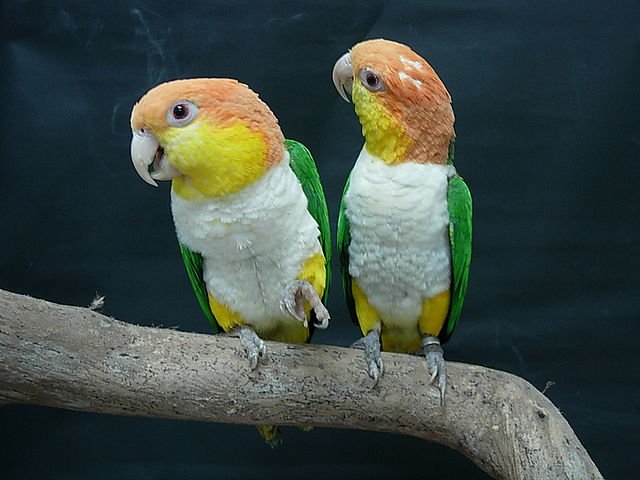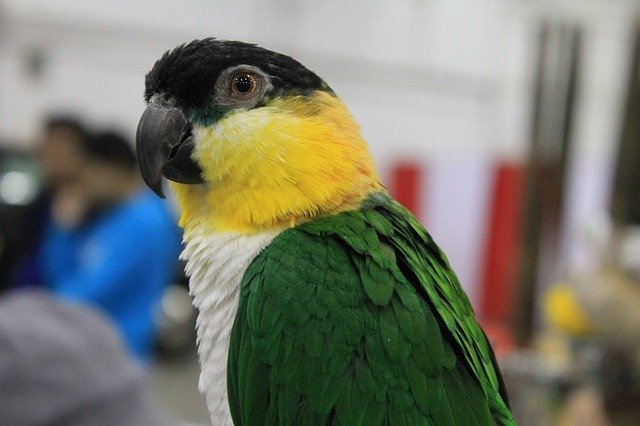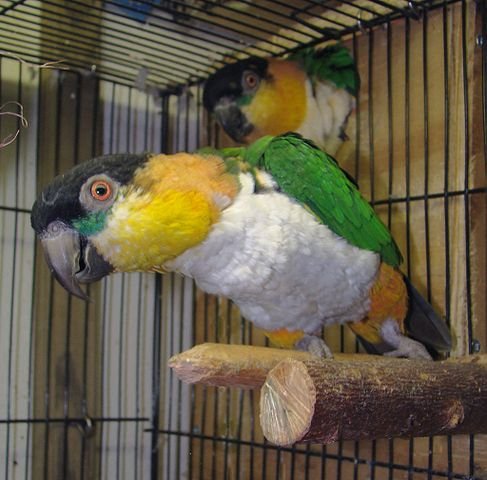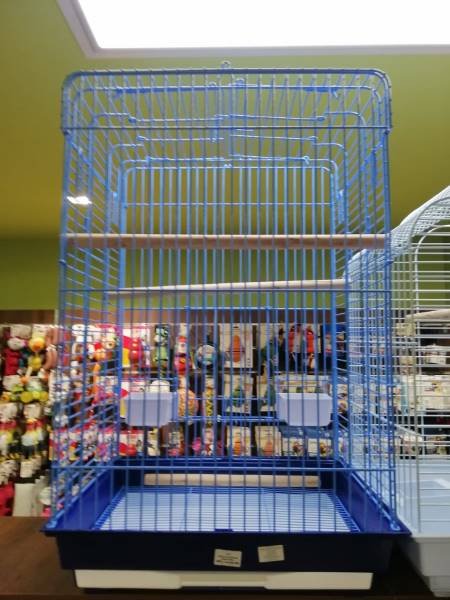When talking about the most colorful and mischievous parrots, what comes to mind is Caiques. These wonderful parrots are delightful to hold. It’s very common to hear Caiques as ‘the clowns of the parrot kingdom’, courtesy, their energetic, fearless, and bold nature. These medium-sized parrots have bounteous attitudes. They have a lifespan of about 25-40 years.
What makes them unique is the white belly. They are also called Seven-colored parrots. Caiques have two major species: White-bellied Caique and the Black-headed Caique, which are further divided into five subspecies. While all the Caiques have a white belly, a black-headed caique has a unique black feather section on the top of its head.
How to Determine Caique Gender
Knowing a Caique’s gender may be quite tricky, as there is no such dimorphism in male and female Caiques. The only way to determine the sex of a Caique is to operate logical testing. However, a maestro can guess about gender identity through their behavior, but there is no such specific behavior to consider. Nevertheless, let’s learn the few basic facts which can be used as a basis to determine Caiques’ gender :
Size of Caiques
Size of male Caique
The Caique males are slightly larger than their female counterparts. The average size of a male Caique could be anywhere between 10 to 12 inches. And this size is almost uniform among all its subspecies namely; Green-thighed, Yellow-tailed, Black-legged, and Black-headed.
Size of female Caique
The Caique females tend to be smaller in size when compared to the male birds. Their average size may range from 8.5 to 10.5 inches depending on genetic factors. And as in males, this size carries uniformity among all its subspecies.

Weight of Caiques
Weight of male Caique
Considering all four subspecies of the Caique family, the weight of all the male subspecies ranges between 150-170 grams. And this average weight tends to be higher than their female counterparts.
Weight of female Caique
For all fur female Caique subspecies, the average weight stands a little lower than that of their respective male subspecies. It might range anywhere between 160-180 grams.
Bill of Caiques
Bill of male Caiques
The bills of males of all four Caique subspecies are comparatively bigger and wider than their respective female counterparts. This difference is enough for the expert eyes to tell both the sexes apart.
Bill of female Caiques
The bills of female Caiques, as discussed, is smaller and rounder in shape. And this pattern difference is uniform in all four Caique subspecies.
Wingspan of Caiques
Wingspan of male Caiques
The wingspan of male Caiques averages near 14 inches among all the four subspecies. This happens to be comparatively broader than their female counterparts.
Wingspan of female Caiques
The wingspan of all four subspecies of female Caiques tends to be narrower than their respective male partners and generally averages around 12 inches.
Behavior of Caiques
The Behavior of male Caiques
The male Caiques are found to be more aggressive than females. Though most of this anger surfaces around the breeding season, they have a general temperament of being aggressive towards other birds. This kind of aggression is seen in all the four subspecies of Caique males.
The Behavior of female Caiques
Female Caiques are timid and shy most of the time. The only time they get aggressive is during the breeding season. Nonetheless, the intensity of that aggression is comparatively much less than their counterparts. Like males, this behavioral difference is prevalent in all the female Caique subspecies.
Cost of Caiques
Cost of male Caiques
Male Caiques are generally adopted Caiques and they are comparatively inexpensive. They may not be friendly with the other birds in the house and when being aggressive, they tend to deliver harsh bites.
Cost of female Caiques
The female Caiques are more expensive and found rare as a pet. Their rarity makes them a premium.
Medically examining Caique gender
Generally, Caiques attain sexual maturity at an age of 2 but it is advised to wait for breeding until they are 3-4 years old. A DNA sexing or surgical sexing must take place to know the possibility of breeding. A breeder can analyze the sex of the Caiques depending on their behavior, but this may not be 100% accurate.
To be sheer sure about a Caique’s gender, any one of these three tests can be done:
Surgical sexing / Endoscopy
Surgical sexing is the most primitive form of determining the sex of the bird, and so does apply to the Caiques. Sexing by endoscopy is a valuable diagnostic method in birds. It is a widely used procedure in monomorphic parrots. This technique must be performed by a skilled veterinarian or an expert clinician. This laceration will also help in determining the health state of a parrot. The parrot may be exposed to great pain during this procedure.
For performing surgical sexing, the veterinarian first disinfects the skin and uses a scalpel razorblade to create a 2-3 mm surgical prick. Care must be taken not to incise the underlying muscle. Next, the surgeon uses the trocar-cannula device to puncture a hole through the abdominal wall. The device has to be held perpendicular to the Caiques’ body and angled slightly dorsally and cranially. This process is done to make space for inserting the endoscope, and can only be used on the birds that weigh more than 60g. Caique is one of them.
Now that the laparoscope or otoscope is inserted, the exact location of the tip can be verified by visiting. If it is still in the abdominal air sac, the surgeon can gently push the lens tip against the air sac membrane to puncture it. The operation is made to visit the sex organs located internally near the front portion of the kidney. At last, the parrot is then tattooed to verify that he has been sexed. The necessity of anesthesia is a drawback of this operation as this may cause infections in the bird.
Caique DNA Sexing
DNA sexing is the most appropriate way to determine gender and the results are authentic too. Commercially practiced from the 1990s, this is a non-surgical and non-antithetical process. The operator can be a veterinarian, a breeder, or the owner since the process is easy.
DNA sexing can be performed on blood cards or feathers. Feathers of the parrots are plucked for the sample, or a blood sample is collected by clipping the parrot’s toenail (blood card). There are DIY kits available in the market to put the collected samples in it and get the report.
DNA with feather tests are the easiest and least invasive way to choose. Being less risky, inexpensive, and easy to operate, DNA sexing is the most veritable method to use.
Chromosomal Analysis
Since the 1980s, chromosomal analysis has gained support for sexing bird’s gender for being non-invasive. The method studies the sex chromosomes Z and W. The male parrots are homogametic and they contain two Z chromosomes (ZZ), and the female parrots are heterogametic and their chromosomes set contains a combination of sex chromosomes ZW. Gender determination can also be proved based on the presence or the absence of a W-chromosome or a specific sequence of W-Chromosomes.
A medical examination of the presence of chromosomes’ sequence well determines the exact gender of the bird. The process starts with plucking the blood feather of the bird and immediately sending it to the testing laboratory. Any delay can cause compromised results. The chromosomes are identified via cell culturing performed on the feathers. But the method has its disadvantages too with 2 weeks of turnaround time being the biggest one.
Summing Up
Learning more about these sprightly bird species, Caiques are the most playful and independent parrots. Fond of the soft surfaces, they take a liking to play over cushions and pillows. Caiques love it when given a big bath-tub. These parrots may not be perfect while talking with a human but are excellent at environmental mimicry. Caiques, whether male or female, are full of excitement and exploration. And irrespective of them being a male or a female, they are considered a great companion for humans.




